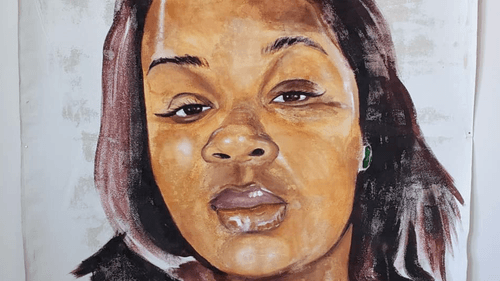Stay in the Loop
BSR publishes on a weekly schedule, with an email newsletter every Wednesday and Thursday morning. There’s no paywall, and subscribing is always free.
The art of justice
Mural Arts and AAMP present ‘Rendering Justice’

It’s hard to imagine a timelier and more essential digital exhibition than Rendering Justice, curated by Jesse Krimes and presented by Mural Arts in partnership with the African American Museum in Philadelphia (AAMP), arriving amid ongoing protests and calls to overhaul a deeply flawed and malevolently racist criminal-justice system, a contentious presidential election and its aftermath, and the continuing pandemic.
Mirror and imagination
“In the midst of our national reckoning, Rendering Justice centers the people and perspectives that are often hidden by racism, criminalization, and other forms of oppression,” Krimes says of the show’s unflinching view of contemporary America, and particularly Philadelphia. After a year full of protests against the murders of George Floyd, Breonna Taylor, and Walter Wallace Jr., a Black man from West Philadelphia, the exhibition holds up a mirror to Black people’s gross vilification in a criminal-justice apparatus rooted in slavery. Through the eyes of artists who were formerly incarcerated or who have personally affected by the criminal-justice system, the show also demands an affirmative reimagining of how people maintain a sense of identity, reclaim their agency, and wrestle with coercive forces until—and after—they re-enter society.
Krimes, himself formerly incarcerated and now an internationally recognized artist, curates work by nine artists, some from Philadelphia. Among then are fellows of the Mural Arts Reimagining Reentry program, which supports formerly incarcerated artists in creating public art projects, and the represented pieces were created through workshops with men incarcerated at SCI Phoenix, women incarcerated at Riverside Correctional Facility, young men and women in Mural Arts Philadelphia’s Restorative Justice Guild and Art Education Programs, and formerly incarcerated members of the larger community.
Reverence and examination
Russell Craig’s Prophesied is a grand portrait that currently hangs on the exterior of AAMP’s building. His likeness of fellow artist James “Yaya” Hough overlays a patchwork-style canvas of sewn-together recycled leather handbags. Hough, also featured in the exhibition, served as a mentor to Craig while incarcerated at SCI Graterford. Craig’s collage of tough and tanned dismembered leather bags calls attention to both the oppression and brutality from law enforcement, and mass incarceration of Black people. Craig uses a similar technique for Nipsey triptych, stitching pieces of leather together to overlay various profiles of slain rapper Nipsey Hussle. Departing from patchwork, the artist also captures the likeness of both George Floyd and Breonna Taylor with acrylic on raw canvas, invoking reverence and remembrance of their lives lost and the pursuit of justice in an unjust system.

Hough, released in 2019 after serving 27 years of a mandatory life-without-parole sentence, was the inaugural muralist of the artist-in-residence program at the Philadelphia District Attorney’s office. His works are some of the most striking of the exhibition. Untitled, a paper collage that features various Louis Vuitton monogram prints spliced together, unveils praying hands and a hood of sorts with cutouts for eyes, though they remain blank. Ahmaud Arbery depicts the February 23, 2020, murder of Ahmaud Arbery, a Black man jogging in Glynn County, Georgia, when he was chased and fatally shot by vigilantes. In 40 watercolor portraits, Hough vividly illustrates Arbery’s murder, utilizing repetition while referencing Eadweard Muybridge’s stop-motion photography. Hough’s stark strokes of black, blue, and dark green with streaks of yellow, representing the road where the killers chased Arbery down, force the viewer to slow down and examine the horrific event in excruciating detail.
Restoring voices
Artist Titus Kaphar and poet Reginald Dwayne Betts collaborate on Redaction, a wall of portraits overlaid with text from the Declaration of Independence. The pair asked each subject to redact, in thick black lines, as much of the historical text as they wished. Expansive both in its size and depth, Redaction pointedly critiques US founding principles, while confronting the criminal-justice system’s abuses and giving voice to the lives left out of the initial promise.
Jared Owens confronts the system’s cruelties through abstract expressionism. Owens, who began painting while in federal detention, has five works in the exhibition: bête noire, Parchman, The Crucifix, If You Don’t Learn We Burn, and Last Nerve. bête noire, Parchman, and The Crucifix weave a similar story, using black paint and featuring materials from the prison yard such as dirt, soil, and gravel to convey the isolation and loneliness people face while confined in horrific environments. In If You Don’t Learn We Burn, Owens creates an abstracted figure in the throes of civil unrest following the murder of George Floyd. The artist uses burned repetitive patterns in the piece’s edges to reference film rolls and the repetition of time—an allusion to police brutality’s constant recurrence. In PhilaGuernica, an outdoor mural at 11th and Callowhill Streets, Owens uses similar techniques, with muted grays etched like pencil drawings that take on Picasso’s Guernica, turning a dystopian representation into an optimistic view of Philadelphia’s youth culture through the addition of bright colors and playful iconography.

Renewed life
Photographer and artist Deborah Willis captures mugshot-style portraits of formerly incarcerated people, but with an unusual format. She frames these subjects below their faces, with only their hands and torsos in view. Her subjects are fashionably dressed, conveying a sense of success. Similarly, photographers Michelle Daniel (Jones) and Michael Koehler collaborate for Point of Triangulation: Intersections of Identity. The set features eight formerly incarcerated leaders from Philadelphia, each captured in a pair of images: a black-and-white photograph reminiscent of a police mugshot and a full-color version depicting people in joyous expressions and powerful stances. Images by Willis, Daniel (Jones), and Koehler exude a level of hope and pride for renewed life post confinement.
Rendering Justice, available to view for free online through the AAMP website, is a sobering yet uplifting feat against the backdrop of our nation’s fixation on imprisonment. Some dreams may be deferred, but they are never extinguished.
Image description: A collage by James “Yaya” Hough. Disjointed images of Louis Vuitton leather and logos compile into a hooded human figure with empty holes for eyes and brown-skinned hands coming together in front as if praying.
Image description: A painted portrait on canvas by Russell Craig. It’s the face of Breonna Taylor, a Black woman in her 20s. Her expression is direct, calm, and slightly inquisitive.
Image description: A photo portrait by Deborah Willis. It’s a close-up on a standing person, showing them from about elbow-level to mid-thigh. The person is folding their tattooed hands in front of them. They have brown skin and are wearing a light-blue linen suit.
What, When, Where
Rendering Justice. On view digitally through January 3, 2021, via the African American Museum in Philadelphia, and Mural Arts. (215) 574-0380 or aampmuseum.org.
Sign up for our newsletter
All of the week's new articles, all in one place. Sign up for the free weekly BSR newsletters, and don't miss a conversation.

 Jared Michael Lowe
Jared Michael Lowe